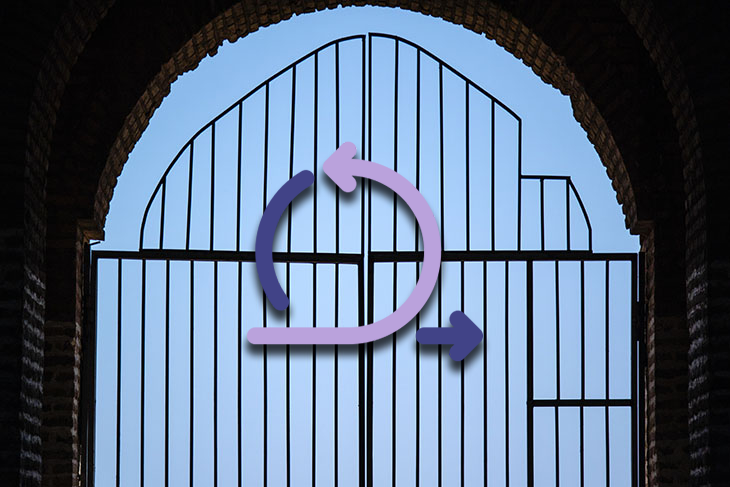As an IT professional and former product owner, I hated and loved the stage-gate process (aka the phase-gate process). Done right, it can save you and your company a lot of trouble and minimizes your risks. Done wrong, it will cost you time and resources.

Let me walk you through the positive and negative sides of the stage-gate process so you can avoid major mistakes.
The stage-gate process divides a project into different phases, so-called stages, with gates in between them. These gates can be seen as decision points with reviews where the results of the previous phase are presented to stakeholders. These stakeholders have the power to decide whether the project may proceed to the next phase and be granted more resources (or not).
Another way to look at the gates is as milestones that measure the progress of the project. With the phase-gate process, you can reduce project risks and improve communication and transparency.
Resources are scarce and projects are always exposed to a certain risk of failure.
To counteract these risks and avoid putting too many resources into projects that can ultimately fail, the stage-gate process defines five phases and gates in between these phases:
Whenever a project completes one phase and is ready to move on to the next phase, it must go through a gate review. A steering committee must determine if the project can proceed, has to repeat the stage, needs to stop, or is good to proceed to the next stage under special conditions.
Every stage and stage-gate review represents a possible exit to save resources. The stages act as a touchpoint to influence the project and ultimately minimize risk.
Let’s break down each stage in detail.
The idea generation stage is often also referred to as the ideation stage. It’s where several people from different fields of the company find promising ideas for new products and services. They come together and brainstorm for good, initial project ideas and evaluate them based on specific criteria.
This phase serves as a basic orientation for brainstorming, researching, gathering information, and exploring ideas. Often, it involves not only internal staff but also external ones. This is because customers and suppliers provide useful information and articulate needs.
This initial team selects the best idea from the collected pool of ideas and forms a project goal.
Activities in this stage include qualitative and quantitative research methods, idea generation methods, and problem exploration methods such as design thinking.
The goal of this stage is to provide an idea that has enough potential to be worth the effort of implementing it further in the next stages.
The scoping stage is when the product or service idea is further evaluated and developed, and the viability of the idea is analyzed based on various factors. The goal of the phase is to identify whether the idea is viable and represents a market opportunity for the company. Typically, this is the phase where one or more people are accountable for pushing the project idea forward. This means more resources are allocated for this evaluation.
The team conducts detailed research and analysis to understand the market and user needs. They also evaluate the technical feasibility of the project idea. Often, a detailed project plan is made to outline the requirements, risks, and objectives of the project.
Risk assessment is often done with a SWOT analysis and helps the team evaluate the project based on strengths, weaknesses, opportunities, and threats.
The goals of the scoping stage are to:
In this phase of the stage-gate process, the team creates a comprehensive business case and plans to commercialize the idea. The team may conduct a feasibility study and a detailed project plan.
Often, a business plan document or a business model canvas is used to map out all the important aspects of a viable business strategy. The goal of this phase is to minimize the commercial risk of the product or service through planning the project and business model.
Specific activities in the stage include:
In the stage-gate review, the steering committee will make sure that the project is well-planned and that the business model is feasible. This will enable them to allocate more resources and invest in further stages of development and commercialization.
In this stage, the team develops the product or service. The team is usually built up and engineers are added to it.
During this development phase, the team uses the details of the business and project plans to develop the product or service. During this development, the team will also execute tests and validations to ensure that the product or service meets the requirements and specifications outlined in the project plan.
The goal of the development is to create a product or service that is ready for commercialization. The gate review, therefore, ensures that the outcome of the development is ready to release to the market.
Major activities in the development stage are:
In the launch stage, the composition of the team changes — fewer engineers are needed and sales and marketing specialists are included in the project. The team prepares the product or service to be released to the market. They create a distribution, sales, and marketing plan and execute the plan from the business model and project plan. Special strategies are refined, like pricing, promotions, and marketing strategies.
The goal of this stage is to successfully launch the product or service to the market and sell it to target customers. In the gate review, the product’s performance in the market is presented to the steering committee.
Major activities in this stage are:
The noun “gate” can be used literally as a passageway or entrance, but also more abstractly as a means of access such as “the gateway to wealth.” In the stage-gate process, we view gates and gate reviews as a formal method of controlling project risks and monitoring changes in project scope.
A stage-gate review is usually held when the project completes one phase and needs to continue with the next higher phase. These are transition points of the project where it undergoes a change and the focus of the work shifts from one area to another.
In the next phase, the project often requires more resources, which means that the steering committee and stakeholders must make investments. On the one hand, investments will incur increased risk and expenses, but on the other hand, will also increase the reward in case of success.
Gate reviews serve several purposes, they:
The steering committee in the stage-gate process consists of different stakeholders and sponsors. Often, it’s senior employees and managers who can act as sponsors to the project. They can assign resources to the project and make “go” or “kill” decisions.
A special role in the stage-gate process is the gatekeeper. The gatekeeper should not be a sponsor, but an independent person. Their job is to negotiate the formal expectations and requirements for the project to proceed from one stage to the next, as well as ensure that the project meets these requirements and expectations.
A gatekeeper also ensures that the project stays aligned with the overall goals and objectives of the organization.
Before a project starts a stage-gate process, the details, requirements, and expectations for each gate must be clear to everybody involved. For each gate, there must be a concrete definition of deliverables and objectives. Each gate must include the following:
The team must meet all these objectives and deliver all the needed artifacts before a gate review is held. In the gate review, the steering committee and the gatekeeper revisit these artifacts and decide how to proceed.
There are five decision options for the steering committee:
The stage-gate process has a couple of advantages and disadvantages against regular project development approaches. This is because it is a structured and systematic approach.
If a classic stage-gate process is used in dynamic markets with rapidly-changing requirements for a product, the market conditions may have already changed so much that the product and project fail during launch. In these cases, the stage-gate process costs more than it brings to the company.
Agile product development, on the other hand, is especially designed for rapidly-changing markets and requirements. In agile product development, very little is known about the needs of the users and the market at the beginning. The market often changes very quickly and the users often do not know what their needs are.
Therefore, in agile product development, development and discovery are often integrated. The strategy is to develop hypotheses about user needs and to confirm or falsify them with MVPs in the market. This reduces product development risk and shortens feedback cycles. Products are developed that are sure to find a market.
However, the stage-gate process in its original form prevents this approach because it is sequentially structured. The stage-gate process can be adapted to take advantage of both the benefits of agile, with integrated product development on the one hand and the control options provided by a steering committee on the other. Instead of working sequentially, the work is integrated. However, the stages represent investment and resource steps.
In the beginning, only a few employees and few resources are invested in an idea. Progress is monitored at each stage-gate and, and if successful, more resources, people, and capital are made available for the team. This process can be compared to the startup venture capital world. A startup is a small, interdisciplinary team that first proves an idea with an MVP prototype on the market and only then searches for more investment. Then there are several rounds of financing and the start-up grows.
The good thing about the stage-gate process is that it provides a good structure and everyone involved knows exactly what to do and how. Resources are not simply released blindly for projects but are used in a targeted manner. The process ensures that projects are aligned with business goals and that risks are minimized.
However, instead of going through the process sequentially, an agile approach with interdisciplinary teams that gradually receive more resources is recommended, especially in very dynamic markets.
Featured image source: IconScout
LogRocket identifies friction points in the user experience so you can make informed decisions about product and design changes that must happen to hit your goals.
With LogRocket, you can understand the scope of the issues affecting your product and prioritize the changes that need to be made. LogRocket simplifies workflows by allowing Engineering, Product, UX, and Design teams to work from the same data as you, eliminating any confusion about what needs to be done.
Get your teams on the same page — try LogRocket today.

The continuous improvement process (CIP) provides a structured approach to delivering incremental product enhancements.

As a PM, you’re responsible for functional requirements and it’s vital that you don’t confuse them with other requirements.

Melani Cummings, VP of Product and UX at Fabletics, talks about the nuances of omnichannel strategy in a membership-based company.

Monitoring customer experience KPIs helps companies understand customer satisfaction, loyalty, and the overall experience.